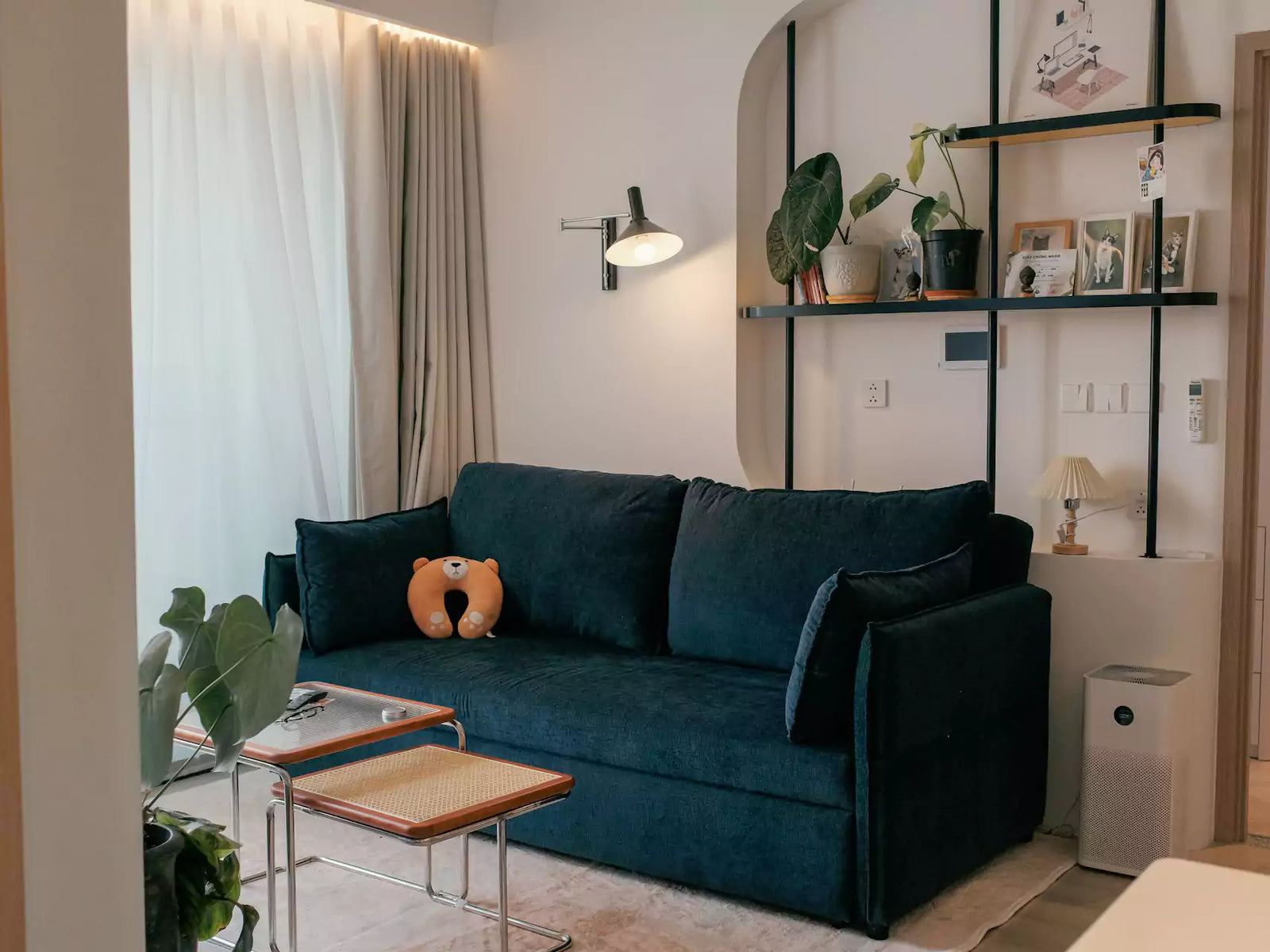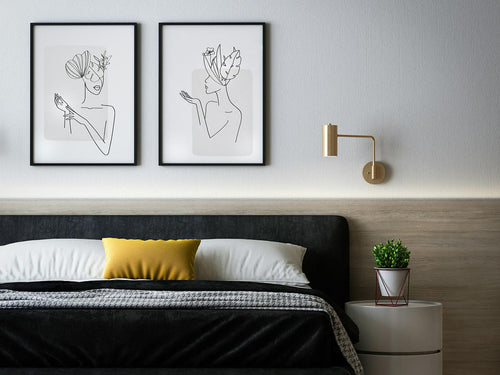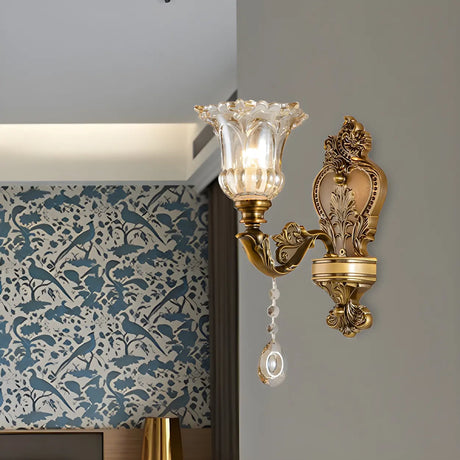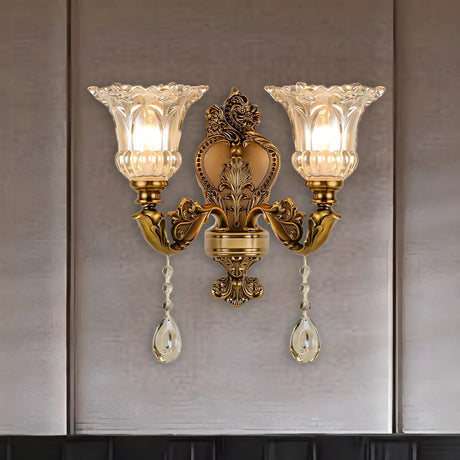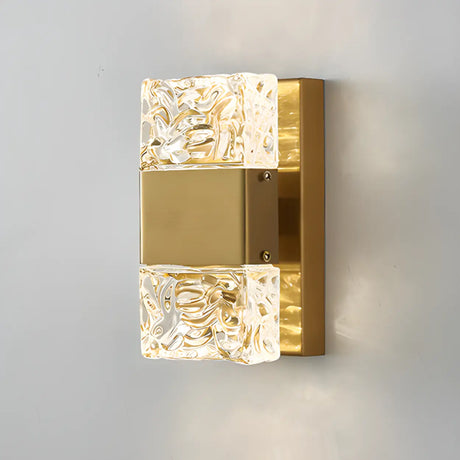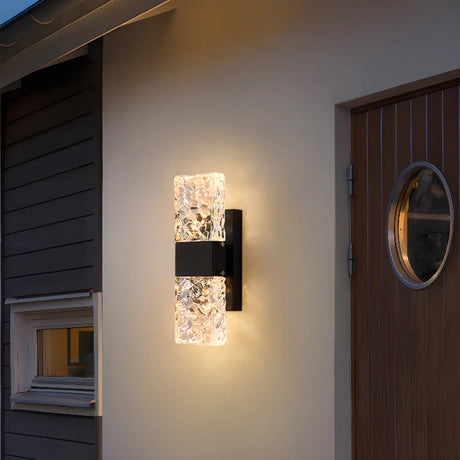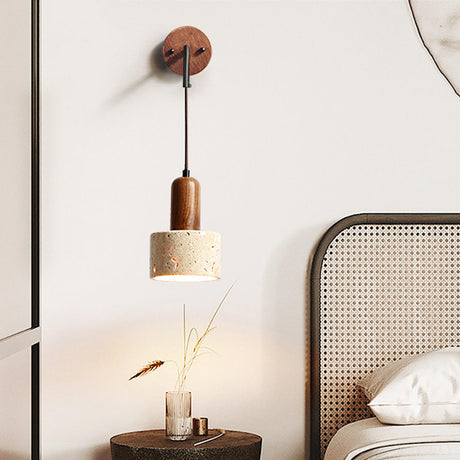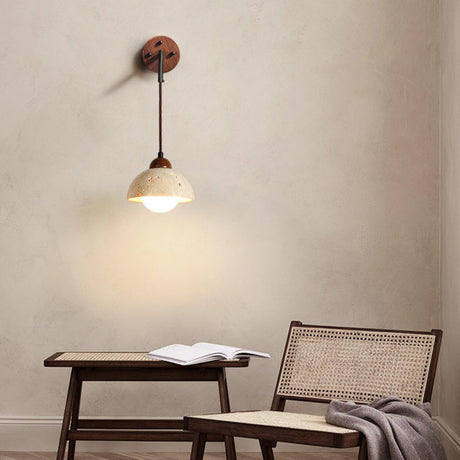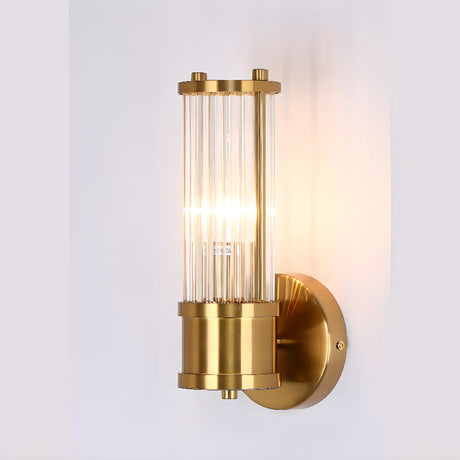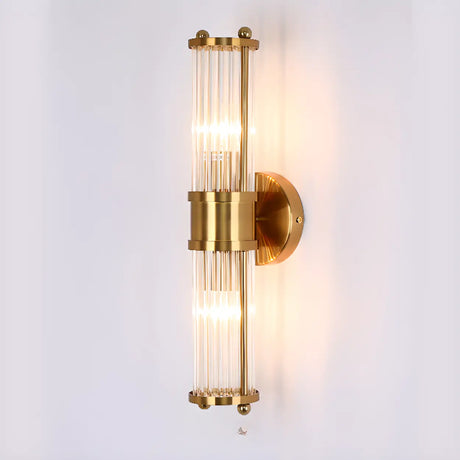Ever walk into a room and feel like something is just... off? You can't quite put your finger on it, but the space doesn't feel balanced. The culprit is often lighting, specifically wall sconces mounted at the wrong height.
A sconce placed too high can cast strange shadows. One placed too low creates annoying glare. Getting it right is simple, but it's a detail that makes a huge difference. This guide will walk you through everything you need to know to place your wall sconces perfectly, every time.
Table of Contents
Wall Sconces Height Chart Quick Reference
Here's your at-a-glance guide to wall sconce heights for every room:
| Room/Location | Recommended Height (inches from floor) | Key Considerations |
|---|---|---|
| General/Living Areas | 65-70 | Standard starting point for most rooms |
| Bathroom - Flanking Vanity | 60-65 | Position at eye level for optimal facial lighting |
| Bathroom - Above Mirror | 75-80 or 6-8" above mirror | Prevents harsh facial shadows |
| Bedroom - Bedside Reading | 24-30" above mattress | Based on seated reading position |
| Bedroom - General | 65-70 | Standard ambient lighting |
| Hallway | 66 | Provides illumination without obstacles |
| Kitchen - Above Counter | 60-65 or 24-30" above counter | Task-oriented lighting |
| Dining Room | 60-66 | Complementary to main lighting fixture |
| Over Furniture | 66-70 | Center over furniture when possible |
| Stairwell | 60-66 from stair nose | Consistent rhythm on stair wall |
| High Ceiling Rooms (9-10') | 72-78 | Adjusted upward for visual proportion |
| Very High Ceilings (10'+) | Up to 84 | Maintains scale with grand spaces |
Why Wall Sconces Height Matters
You might wonder if a few inches really make a difference. They absolutely do. Proper sconce height accomplishes three key things:
- It creates visual balance. Sconces connect the lower and upper halves of a room. The right height makes your space feel cohesive and intentional.
- It delivers functional light. A reading light needs to illuminate your book, not the wall above you. Vanity lights need to light up your face, not the top of your head.
- It ensures comfort. Good placement prevents you from staring directly into a bare bulb, reducing glare and making the room more inviting.
Wall Sconces General Height Golden Rule
If you need one simple rule, here it is: mount wall sconces between 65 and 70 inches from the floor. This puts the light source around eye level for the average person.

However, this is just a starting point. Three main factors will require you to adjust this rule.
Ceiling height
The 65-70 inch rule works perfectly for standard 8-foot ceilings. If your ceilings are higher, you need to adjust.
| Ceiling Height | Try This Height Instead |
|---|---|
| 9-foot ceilings | Bump up to 72-78 inches |
| 10-foot ceilings | Consider 75-80 inches |
| Vaulted or cathedral | Up to 84 inches can work |
Sconce scale & style
A large, dramatic sconce needs more visual space than a small, delicate one. Larger fixtures generally look better mounted slightly higher. Also, consider how the sconce casts light.
- Uplights shine light toward the ceiling and can make a room feel taller.
- Downlights create pools of light below, fostering a cozy atmosphere.
- Multi-directional lights need careful placement to avoid shining directly into someone's eyes.
The room's purpose
Think about how you use the space. Are you lighting a path, performing a task, or setting a mood? A sconce for ambient light in a living room will have different needs than a task light over a kitchen counter
Room-by-Room Wall Light Height Recommendations
Here's how to apply these principles to specific rooms in your home.
Bathroom sconce height
Bathroom lighting is all about function. You need clear, shadow-free light.
- Flanking a Mirror: This is the best option. Mount sconces on both sides of the mirror at 60-66 inches from the floor. This places them at eye level, casting even light across your face. They should be about 28-36 inches apart.
- Above a Mirror: If you only have space for one fixture, mount it above the mirror at 75-80 inches from the floor. Make sure the fixture is no wider than 75% of the mirror's width.

Bedroom sconces
Bedroom lighting should be comfortable and convenient.
- Bedside Reading Sconces: Forget floor measurements. Sit up in bed as if you were reading. Have someone mark the wall a few inches above your shoulder. That's your ideal height. It's typically 24-30 inches above the mattress. Most importantly, make sure you can easily reach the switch without getting out of bed.
- General Ambient Sconces: For sconces not used for reading, the standard 65-70 inch height works perfectly.
Pro tip: In bedrooms, dimmable sconces give you flexibility for both practical tasks and creating ambiance.

Hallway and entryway wall sconces height
In transitional spaces, you should create a welcoming path of light.
Mount hallway sconces at 66-72 inches from the floor. This is high enough to illuminate the space broadly without creating glare at eye level as people walk past.
For spacing, a good rule of thumb is:
| Hallway Length | Sconce Spacing |
|---|---|
| Short (under 10 feet) | One centered fixture may suffice |
| Medium (10-20 feet) | Space fixtures 6-8 feet apart |
| Long corridors | Maintain 6-8 foot spacing for consistency |
Entryways deserve special attention since they create first impressions. For a welcoming feel, position sconces at about 66-72 inches in standard entryways. If you have a grand foyer with high ceilings, you can go higher - up to 78 inches can work beautifully.
Accessibility Considerations
If you're designing for a home where wheelchair users will be present, or for commercial spaces subject to ADA requirements, keep sconces above 80 inches from the floor unless they project less than 4 inches from the wall. This prevents them from becoming hazards at head height for people with visual impairments.

Living room sconces height
Living room sconces are often decorative and serve as design elements that frame features or create focal points.
- Flanking a Fireplace or Artwork: Mount sconces at 66-72 inches to draw the eye and create a balanced, symmetrical focal point. Position them so they feel connected to the object they are framing, typically 8-12 inches from the side of the mantel or art frame.
- Next to a Media Wall: To prevent distracting screen glare, position sconces far enough to the sides of the television. The light should illuminate the wall, not reflect off the screen.

Kitchen & dining room sconces
- Kitchen: While kitchens are dominated by overhead lighting, sconces can add a beautiful layer of task or accent light. For task lighting over a counter area without upper cabinets, mount sconces about 24-30 inches above the counter surface. This places the light exactly where you need it for food prep.
- Dining Room: Here, sconces are purely for ambiance. They should provide a soft glow that complements your main chandelier, not competes with it. Mount them at 60-66 inches, which is low enough to feel intimate but high enough not to interfere with guests.

How to Choose the Perfect Sconce
Before you can finalize your measurements, you need to choose a fixture. The type of sconce you select will have a major impact on both the style of your room and the quality of the light.
Choose by function
The engineering of a sconce dictates how it directs light, which in turn shapes the atmosphere of your room.
- Uplight: This style directs all its light towards the ceiling, which then reflects it down into the room. This creates a soft, diffuse, and even glow that is free of glare. It's an excellent choice for ambient lighting and can make rooms with lower ceilings feel taller and more spacious.
- Downlight: This type casts a focused, often dramatic, pool of light below the fixture. It's perfect for task lighting over a workspace or for creating a cozy, intimate mood in a dining room or reading nook. It can also be used to highlight an architectural detail or a piece of art on the wall below.
- Swing-Arm: The ultimate in functional lighting, a swing-arm sconce has an adjustable arm that allows you to direct the light exactly where you need it. This makes it the perfect choice for a bedside reading light or for task lighting in a home office nook where flexibility is key.

Choose by Style
A sconce is a decorative element, and its style should complement the overall design of your room.
- Modern: This style is defined by clean lines, simple geometric shapes, and unadorned finishes, often in materials like chrome, nickel, or matte black. Modern sconces are minimalist and focus on form and function.
- Industrial: Inspired by old factories and warehouses, this style features raw materials like iron, brass, and steel, often with exposed bulbs and a rugged, utilitarian feel. It pairs well with loft spaces, brick walls, and vintage decor.
- Farmhouse: This popular style is all about creating a cozy, rustic, and welcoming feel. Look for materials like distressed wood, oil-rubbed bronze, and classic lantern shapes. Farmhouse sconces add a touch of charming, homespun character.
- Traditional: Drawing from classic European design, traditional sconces are often more ornate. They may feature details like curved arms, candle-style bulbs, fabric shades, and elegant finishes like polished brass or crystal.
Installation Basics: A DIY Primer
Once you've chosen your sconce and finalized your height, it's time to think about the practicalities of installation. You have two main options, each with its own pros and cons.
|
Feature |
Plug-in Sconce |
Hardwired Sconce |
|---|---|---|
|
Ease of Install |
Very Easy. Mounts to the wall with screws like a picture frame. |
Difficult. Requires knowledge of electrical work. |
|
Aesthetics |
A visible cord runs down the wall to an outlet. |
No visible cords for a clean, seamless, professional look. |
|
Cost |
Generally less expensive, and no electrician is needed. |
The fixture can be more expensive, plus potential electrician fees. |
|
Permanence |
Easy to move or take with you when you leave. Perfect for renters. |
A permanent fixture that adds value to your home. |
If you choose to hardwire a sconce, always prioritize safety above all else. This is a general overview, not a substitute for professional guidance.
- Safety First: Turn off the power at the circuit breaker that controls the room you're working in.
- Mark Your Location: Use a pencil and a level to precisely mark the center point for your electrical box.
- Cut Drywall & Install Box: Use a stud finder to ensure you have a clear bay between studs. Trace your "old work" electrical box and carefully cut the hole.
- Run Electrical Cable: This is often the most challenging step for DIYers, as it involves fishing a new cable from a power source (like a nearby outlet) to the new box location.
- Connect Wires & Mount Fixture: Follow the manufacturer's instructions carefully to connect the black (hot), white (neutral), and copper (ground) wires before securing the fixture to the wall.
If you are not 100% comfortable and knowledgeable about electrical work, hire a licensed electrician. It is always the safest choice.
Common Mistakes to Avoid
Even with the best intentions, a few common mistakes can derail your lighting plan. Here's what to watch out for.
| Common Mistake | Better Approach |
|---|---|
| Mounting all sconces at exactly the same height throughout a home | Adjust height based on room function and ceiling height |
| Placing sconces too close to corners | Keep sconces at least 24-36 inches from corners in most cases |
| Ignoring the relationship between sconce size and mounting height | Larger sconces generally need higher placement |
| Focusing only on measurements, not eye level | Remember that comfort and function trump rigid adherence to numbers |
Perhaps the biggest mistake is treating measurements as absolute rules rather than starting points. Your home's architecture, your fixtures' design, and your family's needs should all influence your final decisions.
Final Thoughts
These guidelines and rules will give you a fantastic, technically sound starting point. They provide the foundation for a well-lit, beautifully balanced room and will help you avoid the most common mistakes.
But at the end of the day, lighting is also an art. After you've done your measuring, take a moment to visualize. A great trick is to cut a piece of paper to the size of your sconce and use painter's tape to stick it on the wall. Live with it for a day or two. See how it feels in your space, with your furniture, from different angles. The tape measure will get you 90% of the way there, but your own eye is always the best final judge.
FAQ
Should sconces match the height of nearby outlets and switches?
Should sconces match the height of nearby outlets and switches?
Not necessarily. Electrical outlets are typically placed 12-16 inches from the floor, while switches are at 48 inches. Sconces serve different purposes and should be placed according to their function rather than aligning with other electrical elements.
How do sloped ceilings affect sconce placement?
How do sloped ceilings affect sconce placement?
With sloped ceilings, maintain consistent height from the floor rather than trying to maintain equal distance from the ceiling. This creates a more balanced look as the eye naturally follows the floor line more than the ceiling line.
What about sconces in stairwells?
What about sconces in stairwells?
Stairwell sconces present unique challenges. I recommend placing them at approximately 60-66 inches from the nose of the step directly below each fixture. This creates consistent illumination throughout the staircase while maintaining a visually pleasing rhythm.
Can I install a sconce over upholstered furniture?
Can I install a sconce over upholstered furniture?
Yes, but give it breathing room. Keep sconces at least 18-24 inches above the top of a sofa or upholstered headboard to prevent damage to the fixture and minimize fire hazards.

